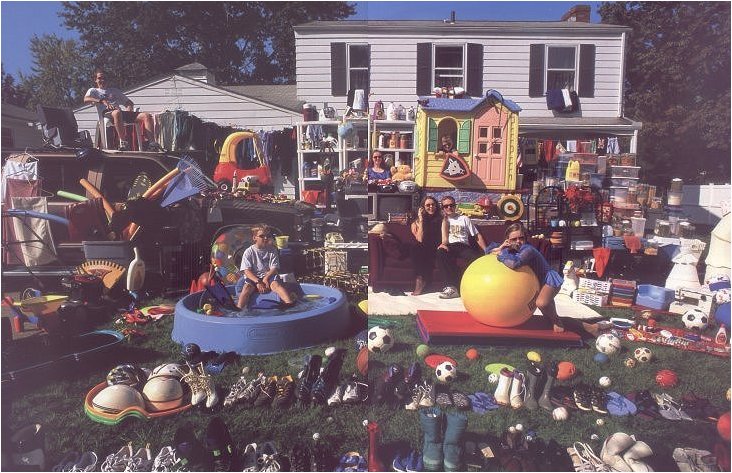| Commodities
What
do we depend on oil for?

This
dramatic photograph appeared in National
Geographic Magazine's June 2004 issue. It shows a family of
two adults and five children surrounded (overwhelmed?) by their
belongings, made mostly from oil-based polymers.
The
Economy of New Zealand is a market economy which is greatly
dependent on international trade. It is strongly dependent
on tourism and agricultural exports, and has only small manufacturing
and high-tech components. Earnings from agricultural exports and
tourism currently fail to cover the imports of advanced manufactured
goods required to sustain the New Zealand economy.
- en.wikipedia.org/wiki/Economy_of_New_Zealand
Possible
Solutions
Unfortunately,
as so well illustrated above, with nearly everything in our daily
lives requiring some oil input, switching exclusively to items
with absolutely no oil input may not be a practical option. However,
at least reducing our dependency now
may make the transition a little easier when the cost of many
oil-dependent commodities renders them no longer affordable for
most of us.
Food
—
growing you own organically will eliminate many petrochemical
transportation and fertilizer costs, not to mention the health
benefits
—
see
our Food page for more
information and resources
Buy
locally produced
—
unfortunately,
often easier said than done, especially with NZ's less than
perfect labelling laws
—
you
may pay an initially higher initial price for local product
but, in addition to workers being paid fairer wages, have you
also considered quality and durability - will your cheaper import
be repairable in 18 months time?
—
be
wary of labels stating made for New Zealand,
distributed by xxx in New Zealand,
made from local and imported ingredients
etc - the bulk of the product may still have been made and transported
from the other side of the globe
Buy
only what you Need
—
we all need a treat once in a while, but to do really need
to upgrade your iPod, a new car every two years, or a new wardrobe
simply because your old clothes are last year's fashion?
—
try
to distinguish needs from wants
Make and Repair
—
revive the lost art of fixing rather than throwing
away
—
learn
to use hand tools, sewing and craft tools
—
recycle
items by repairing them yourself wherever safe and practical
to do so
— learn as many maintenance,
craft, and building skills as you can now (library,
evening classes?)
Resources
These
PDF documents will require that you have installed on your computer
a PDF reader such as Adobe Reader, or the much more compact Foxit
Reader, which can be freely downloaded from here.
It
is suggested that, rather than opening a document in your browser,
you right mouse click on the button to the right, and elect to
"Save target as ..." (Explorer) or "Save link as
... (Firefox).
Thanks
go to eHow
for this substantial collection.
| How
to Build a Playhouse
|
 |
| How
to Clean Hard Water Stains off a Waxed Table
|
 |
| How
to Cut Leather
|
 |
| How
to Fix a Hole in your Sock
|
 |
| How
to Fix an Old Wooden Chair
|
 |
| How
to Fix Broken Jandals
|
 |
| How
to Fix Cracked Leather
|
 |
| How
to Make a Hammock
|
 |
| How
to Make Moccasins
|
 |
| How
to Make Twig Furniture
|
 |
| How
to Reclaim Building Timber
|
 |
| How
to Remove and Replace a Zipper
|
 |
| How
to Remove Gum from Fabrics
|
 |
| How
to Repair a Tear in a Jacket
|
 |
| How
to Re-use Cotton Clothing
|
 |
| How
to Set up a Workshop
|
 |
| How
to Sew a Button
|
 |
| How
to Sharpen Woodworking Tools
|
 |
| How
to Tan Deer Hide
|
 |
| How
to Tan Leather
|
 |
| How
to Use Recycled Soles on your Soft-Soled Shoes
|
 |
|
|


